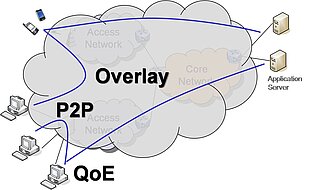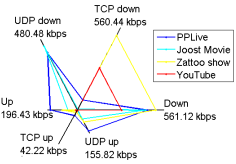IPTV and P2PTV

Future Internet Applications & Overlays
| Head | ||
| Researchers | ||
| Student Helpers | Oskar Smietanka |

IPTV and P2PTV
With increasing acces
s bandwidth speeds for end users, the new Internet-based television (IPTV) has gained popularity as a means of delivering high-quality video content delivery networks. In general, IPTV architectures can be either client/server based, which can be modeled and analyzed using methods from queuing theory, or they can be based on (often proprietary) P2P topologies, referred to as P2PTV. Based also on the different types of offered media content (network-based video recorders, video-on-demand, or live TV streaming) the goal is to characterize the traffic of these networks and identify the impacting factors on the user-experienced quality. As a result of the found interdependency between traffic characteristics and QoE, the system adapts to the current network situation and tries to maintain a certain QoE. An example for such a dynamic QoE control mechanisms includes the usage and choice of scalable / multi-description video codecs and their setting during run-time.
In order to understand the dynamics and emerging overlay topologies of such P2P-based IPTV systems, measurements are useful for further optimization potential. For example, the adaptation of the overlay to the underlying topology of the ISPs of the participating peers might help to improve the QoE of the video stream by reducing delays and improving throughput.



